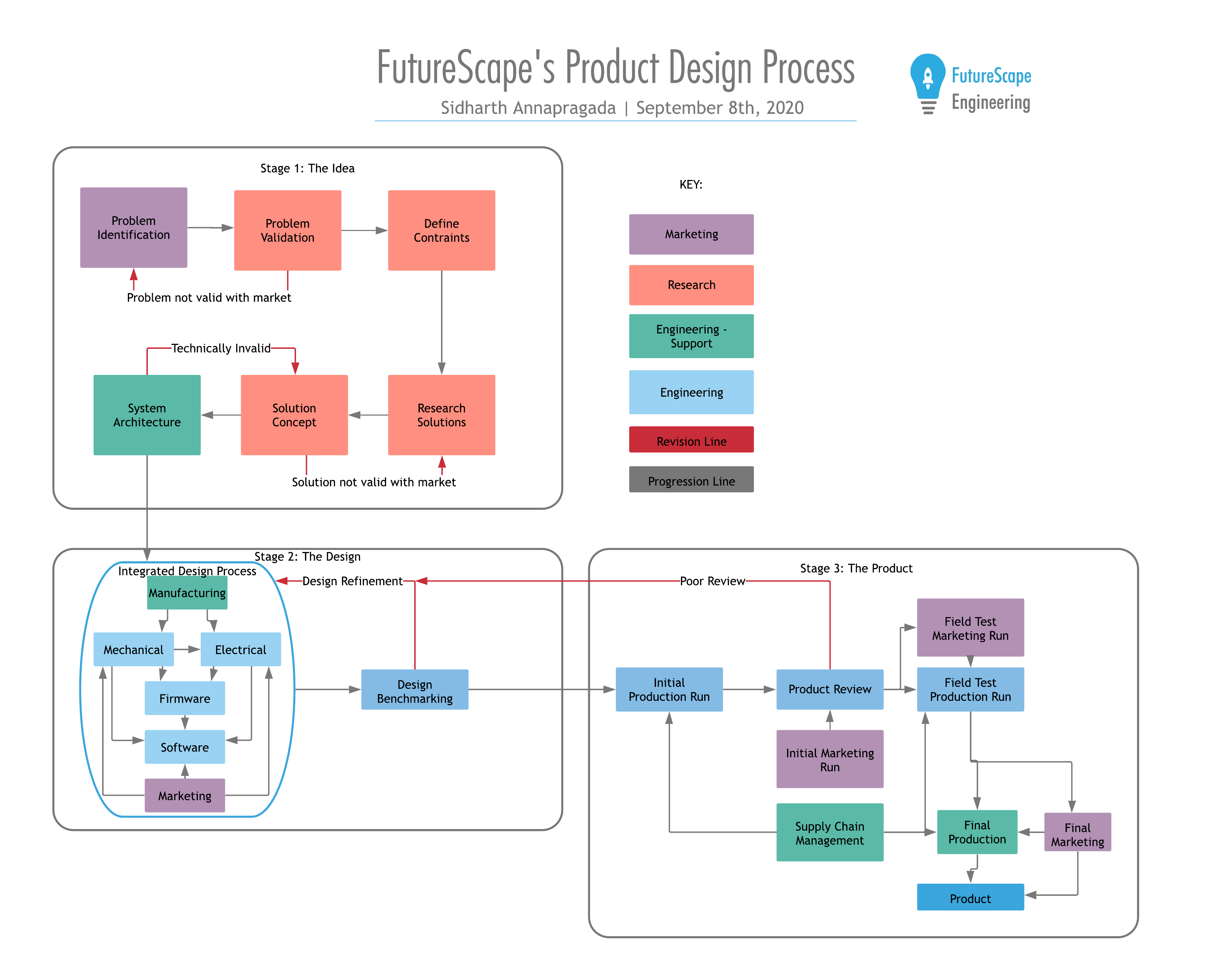Sid A.; July 28th, 2020
This post discusses the product design process that FutureScape employs, presented in an interactive graphical format and updated with biomimicry incorporated.
Product Process

Problem Identification
The first step of the product design process is identifying a challenge that needs to be solved. This can start as a broad topic or goal such as "climate change" or something more narrow like "occupancy detection". If you start broad, then you need to narrow down, through the "problem validation" step, which involves determining if the challenge you are solving is really a challenge that needs to be solved. Climate change isn't necessarily a problem that needs to be solved. Rather, the specific issue of greenhouse gas emission needs to be fixed. Even the problem of greenhouse gas emission is too broad though. Narrowing down enough, you could arrive at occupancy detection in order to turn off lights when rooms aren't in use to reduce energy consumption. Then you need to validate this problem with market research to determine that it hasn't been solved yet and would actually sell as a product.
Define Constraints
Once you have a specific problem that is valid in the market, you need to specify what defines success for the product. Let's take the example of an occupancy detector. Success should be defined in terms of your prior market research. It should be able to work in x environment, operate for a certain amount of time, detect with a certain accuracy etc. These constraints will be refined later, but should be roughly laid out now.
Final Product
The product is complete! The reviews from field testing were satisfactory, the supply chain is set up, manufacturing is good to go, and the ads are running. Remember, you can never relax with a product! The entire process will need constant vigilance and updates to keep the product selling and customers happy.
Integrated Design Process
Once you have a finalized system architecture, it is time to move to the actual design phase. It is critical that you design the product as a system rather than in siloes. Marketing and Manufacturing should be overseeing and informing all design decisions. Electrical and Mechanical engineers should be working closely together along with higher level engineers including firmware and software. By designing as a system, you end up with a cohesive product that is easy to use and easy to make.
Design Benchmarking
Once the integrated design process has produced a prototype design, the design itself needs to be benchmarked and reviewed before moving into actual prototyping. It is at this stage that simulations, discussions with manufacturers, certification specialists, etc. should happen, before moving further. Any problems should be addressed at this stage and the design should be revised.
Initial Product Reviews
You are ready for prototyping! Make a few units, fix any issues, have the marketers review it, and if the prototype is good enough, send those initial units out for field testing. Use the feedback from this testing to refine the design further and repeat this until the product is ready for more widespread testing.
Field Testing
At this stage product certification should be underway or completed. Produce a reasonable quantity of the product and send it out for field testing and review, ideally with actual customers! Use the feedback to further refine the design.
Research Solutions
At this point you have a specific problem and specific constraints. Use these to find existing solutions or components that can help you achieve a solution. The biomimetic design process can begin here as well with the "Biologize" and "Discover" steps. These involve restating your problem in biological terms (Biologize step) so that you can then "ask nature" how it solved these problems (Discover step).For occupancy detection, this might involve asking nature how insects find people/animals to bite.
System Architecture
This is the hardest step of the whole process! Now that you have an idea of what you want to make you need to sit down and come up with your particular solution concept. This will involve an iterative process of breaking down the concept into ultra small problems, brainstorming solutions to each of these, and then amalgamating them back into a system architecture. Then after reviewing the architecture for technical feasibility, you move back to the prior step and refine until there are no aspects of the system architecture that qualify as "technically invalid". From a biomimicry standpoint, these steps are known as "Abstract" and "Emulate". They involve extracting the core biological "design strategies", stated in engineering rather than biological terms, and then forming design concepts that emulate those strategies.

